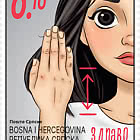Release years
Narrow Gauge Locomotives in the Republic of Srpska
Bosnia and Herzegovina had the most developed network of narrow gauge locomotives in the world. In the time of the biggest prosperity of railway traffic, in the end of fifties of last century, Bosnia and Herzegovina (partly territory of today Republic of Srpska) disposed of 1.500 kilometers of railways with width of 750 mm. All important railway routes in the territory of Bosnia and Herzegovina were made by Austrian-Hungarian occupation Government in the period from 1879 until the end of the first decade of 20th century. "Narrow railways" passed through the beautiful region, and popular "Ciro" became legend for his life. Unfortunately, government of ex SFR Yugoslavia аbolished all narrow gauge railways in today Republic of Srpska and Bosnia and Herzegovina in the period from 1966 until 1979...
Rama
First locomotives for the narrow gauge railways were delivered to Bosnia and Herzegovina late in summer of 1878, and were made by the Factory "Kraus" from Munich. They were very simple, with the power of 20 – 60 KS, and they dragged small travel and cargo trains. Their maximum speed was 15 km/h, and for the first several years they had route Bosanski Brod – Sarajevo and in the railways in the area of Usora, and after they were used for the dragging cargo trains during construction of "narrow railways" in Bosnia and Herzegovina at the end of 19th and in the beginning of 20th century.
From the total of 24 locomotives of this type, only three remained at 20th century: "Rama", "Augusta" and "Ida". The last one disappeared in the First World War, and "Augusta" was used for the spare parts for "Rama" fifty years ago, and "Rama" was the only one saved because of the fact that that was the locomotive that pulled the first train in Sarajevo 1882. Today "Rama" was reinstated and in the driving condition and it was kept in Railway Museum in Pozega (Srbija) and it was the oldest locomotive that was driven in narrow gauge railways in Bosnia and Herzegovina (partly territory of today Republic of Srpska).
JZ 83-056
New era at "narrow railways" in Bosnia and Herzegovina (partly territory of today Republic of Srpska) started in 1903, when Austrian and German locomotives of Bosnia and Herzegovina railways started to deliver strong machines for pulling cargo and passenger trains. Those locomotives, that had mark 83 in the network of Yugoslav railways, were the most numerous and the most confidential machines on the narrow gauge railway. Between 1903 and 1949, 185 machines of this type were manufactured and 178 worked in the ex Yugoslavia railway network.
Locomotives type 83 transferred passengers and cargo to the almost all narrow gauge railways in Bosnia and Herzegovina, except the railways with cogged third rail. They had four bounded axle and special two axle tender. Two pair cylinders developed power from 350 to 400 KS and maximum speed of 35 km/h.
Until today fifteen locomotives of type 83 were kept, from which 83-052 and 83-173 occasionally pulls trains on tourist route "Sargan eight" at Mokra Gora (Srbija), three locomotives work at coal mine in Banovici, and two finished in Austria, where they transport tourists at "narrow gauge railway". Locomotive 83-056, manufactured in 1923, today stands as a monument to the narrow gauge railways in Trebinje.
UNRRA 22
Within the framework of Program of United Nations for Relief and Rehabilitation (UNRRA), Yugoslavia from September 1945 until the April 1946 received 34 steam locomotives for the narrow gauge railway. All those were made in the factory "X.K.Porter" in American city Pittsburgh.
These machines had two bounded axle and special four axles tender, two pair cylinders developed power from 240 KS and maximum speed of 3 km/h, and they had – for that time – very modern design and half closed cabin.
Locomotives UNRRA had route at Drvar-Licka Kaldrma, Drvar-Prijedor, Srnetica-Mlinista-Jajce, Donji Vakuf-Bugojno-Gornji Vakuf and Zavidovici-Olovo-Han-Pijesak. Unfortunately, the only machine of this type decomposes (unknown number) more than 30 years in Mlinista, at the southwest of Republic of Srpska.
Skoda 1937
After the Second World War at the railways of ex "Sipad", most of the locomotives were destroyed or were in very bad shape. Because of that, six new locomotives were ordered from Czechoslovak factory "Skoda", which were capable to overcome high raises and sharp curves at the narrow gauge railways.
Mentioned factory delivered these machines to Yugoslavia in 1948 and these were right away placed into traffic at "Sipad" railways across the mountain Klekovaca, Drvar, across Srnetica, to Prijedor and Jajce.
These locomotives were very powerful and they had five bounded axles and special two axles tender. Their full weight was 52 tons, and two pair cylinders given them the power of 400 KS and maximum speed of 30 km/h.
Locomotive number 1037 pulled the trains most of its work time at the route Drvar-Licka Kaldrma, Drvar-Srnetica-Prijedor and Srnetica-Sanica Donja. After it was used for the mine Banovici, and today – reinstated – proudly stands in front of the Head office of "Railways of Republic of Srpska" in Doboj.
Graphic realization: Bozidar Dosenovic and Nebojsa Djumic
Printing house: POSTE SRPSKE, Banjaluka
Professional help: Goran Barac, publicist from Banjaluka
Bosnia and Herzegovina - Republic of Srpska - Recommended stamp issues
WOPA+ recommended stamp issues
| Avatar - Fire and Ash |
| Issued: 03.12.2025 |
| ›New Zealand |
| 50th Anniversary of the Founding of the 24th November Bar Scout |
| Issued: 24.11.2025 |
| ›Montenegro |
| Krisjanis Valdemars |
| Issued: 02.12.2025 |
| ›Latvia |
| Sign Language - Good |
| Issued: 02.12.2025 |
| ›Bosnia and Herzegovina - Republic of Srpska |
| In Memory of the Fallen and Murdered on October 7, 2023 |
| Issued: 08.10.2025 |
| ›Israel |
| Annual Collection Folder (New York) |
| Issued: 05.12.2025 |
| ›United Nations |
| Year Set |
| Issued: 24.11.2025 |
| ›Isle of Man |
| Shipping in the 17th and 18th Centuries - Peat Shipping |
| Issued: 05.12.2025 |
| ›Netherlands |















































